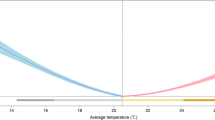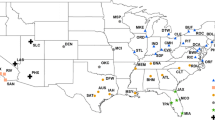Abstract
Poisson regression models were used to evaluate associations between temperature, precipitation, days of extreme heat, and other weather changes (lagged 7 days), as well as El Niño events, with hospitalizations for acute myocardial infarction, angina pectoris, congestive heart failure, and stroke in three California regions. Temperature changes were defined as a 3 °C decrease in maximum temperature or a 3 °C increase in minimum temperature. Temperature and precipitation were analyzed separately for normal weather periods and El Niño events, and for both weather periods combined. Associations varied by region, age, and gender. In Los Angeles, temperature changes resulted in small changes in hospitalizations. Among San Francisco residents 70+ years of age, temperature changes increased hospitalizations for nearly all outcomes from 6% to 13%. Associations among Sacramento residents were similar to those in San Francisco: among men 70+ years of age, temperature changes increased hospitalizations by 6%–11% for acute myocardial infarction and congestive heart failure, and 10%–18% for stroke. El Niño events were consistently and significantly associated with hospitalizations only in San Francisco and Sacramento, and then only for angina pectoris (increasing hospitalizations during El Niño events). These exploratory analyses merit further confirmation to improve our understanding of how admissions to hospitals for cardiovascular disease and stroke change with changing weather. Such an understanding is useful for developing current public health responses, for evaluating population vulnerability, and for designing future adaptation measures.





Similar content being viewed by others
References
Bull GM (1973) Meteorological correlates with myocardial and cerebral infarction and respiratory disease. Br J Prev Soc Med 27:108–113
Curson P (1996) Human health, climate and climate change: an australian perspective. In: Giambelluca TW, Henderson-Sellers A (eds) Climate change: developing southern hemisphere perspectives. Wiley, New York, pp 319–348
Danet S, Richard F, Montaye M, Beauchant S, Lemaire B, Graux C, et al (1999) Unhealthy effects of atmospheric temperature and pressure on the occurrence of myocardial infarction and coronary deaths. A 10-year survey: the Lille-World Health Organization MONICA Project (Monitoring Trends and Determinants in Cardiovascular Disease). Circulation 100:e1–e7
Donaldson GC, Robinson D, Allaway SL (1997) An analysis of arterial disease mortality and BUPA health screening data in men, in relation to outdoor temperature. Clin Sci 92:261–268
Eurowinter Group (1997) Cold exposure and winter mortality from ischaemic heart disease, cerebrovascular disease, respiratory disease, and all causes in warm and cold regions of Europe. Lancet 349:1341–1346
Feigin VL, Nikitin YP, Bots ML, Vinogradova TE, Grobbee DE (2000) A population-based study of the associations of stroke occurrence with weather parameters in Siberia, Russia (1982–92). Eur J Neurol 7:171–178
Hales S, Salmond C, Town CI, Kjellstrom T, Woodward A (2000) Daily mortality in relation to weather and air pollution in Christchurch, New Zealand. Aust NZ J Public Health 24(1):89–91
Glantz MH (1996) Currents of Change: El Niño’s impact on climate and society. Cambridge University Press, Cambridge
Keatinge WR, Coleshaw SRK, Cotter F, Mattock M, Murphy M, Chelliah R (1984) Increases in platelet and red cell counts, blood viscosity, and arterial pressure during mild surface cooling: factors in mortality from coronary and cerebral thrombosis in winter. Br Med J 289:1405–1408
Kloner RA, Poole WK, Perritt RL (1999) When throughout the year is coronary death most likely to occur? A 12-year population-based analysis of more than 220,000 cases. Circulation 100:1630–1634
Kovats S, Bouma M, Haines A (1999) El Niño and health. World Health Organization Task Force on Climate and Health, World Health Organization
Ku CS, Yang CY, Lee WJ, Chiang HT, Liu CP, Lin SL (1998) Absence of a seasonal variation in myocardial infarction onset in a region without temperature extremes. Cardiololgy 89:277–282
Kunst AE, Loopman CWN, Mackenbach JP (1993) Outdoor air temperature and mortality in the Netherlands: a time-series analysis. Am J Epidemiol 137:331–341
Lerchl A (1998) Changes in the seasonality of mortality in Germany from 1946 to 1995: the role of temperature. Int J Biometeorol 42:84–88
Liang K, Zeger SL (1986) Longitudinal data analysis using generalized linear models. Biometrika 73:13–22
McGregor GR (1999) Winter ischaemic heart disease deaths in Birmingham, United Kingdom: a synoptic climatological analysis. Clim Res 13:17–31
Moolgavkar S, Luebeck E, Anderson E (1997) Air pollution and hospital admissions for respiratory causes in Minneapolis-St. Paul and Birmingham. Epidemiology 8:364–370
Morris RD, Naumova EN, Munasinghe RL (1995) Ambient air pollution and hospitalization for congestive heart failure among elderly people in seven large US cities. Am J Public Health 85:1361–1363
Peters A, Liu E, Verrier R, Schwartz J, Gold D, Mittleman M, et al (2000) Air pollution and incidence of cardiac arrhythmia. Epidemiology 11:11–17
Samet J, Zeger S, Kelsall J, Xu J, Kalkstein L (1998) Does weather confound or modify the association of particulate air pollution with mortality? Environ Res 77:9–19
Samet JM, Dominici F, Zeger SL, Schwartz J, Dockery D (2000) Fine particulate air pollution and mortality in 20 U.S. cities, 1987–1994. N Engl J Med 343:1742–1749
SAS Institute Inc (2001) SAS/STAT Software, Release 8.2. SAS Institute Inc. Cary, NC
Schwartz J, Morris R (1995) Air pollution and hospital admissions for cardiovascular disease in Detroit, Michigan. Am J Epidemiol 142:23–35
Seretakis D, Lagiou P, Lipworth L, Signorello LB, Rothman KJ, Trichopoulos D (1997) Changing seasonality of mortality from coronary heart disease. JAMA 278:1012–1014
Smit B, Pilifosova O (2001) Adaptation to climate change in the context of sustainable development and equity. Climate Change 2001: Third Assessment Report of the Intergovernmental Panel on Climate Change. Cambridge University Press, New York, pp 877–912
Tanaka H, Shinjo M, Tsukmua A, Kawazuma Y, Shimoji S, Kinoshita N, et al (2000) Seasonal variation in mortality from ischemic heart disease and cerebrovascular disease in Okinawa and Osaka: the possible role of air temperature. J Epidemiol 10:392–398
Woodhouse PR, Khaw KT, Plummer M, Foley A, Meade TW (1994) Seasonal variations of plasma fibrinogen and factor VII activity in the elderly: winter infections and death from cardiovascular disease. Lancet 343:435–439
Yeh CJ, Chan P, Pan WH (1996) Values of blood coagulating factors vary with ambient temperature: the cardiovascular disease risk factor two-township study in Taiwan. Chin J Physiol 39:111–116
Zanobetti A, Schwartz J, Dockery DW (2000) Airborne particles are a risk factor for hospital admissions for heart and lung disease. Environ Health Perspect 108:1071–1077
Acknowledgements
The authors gratefully acknowledge the support of the California Energy Commission (CEC) under contract 500-97-043 and the Electric Power Research Institute. The views expressed in this article are those of the authors and do not necessarily represent the views and policies of the California Energy Commission or the state of California.
Author information
Authors and Affiliations
Corresponding author
Rights and permissions
About this article
Cite this article
Ebi, K.L., Exuzides, K.A., Lau, E. et al. Weather changes associated with hospitalizations for cardiovascular diseases and stroke in California, 1983–1998. Int J Biometeorol 49, 48–58 (2004). https://doi.org/10.1007/s00484-004-0207-5
Received:
Accepted:
Published:
Issue Date:
DOI: https://doi.org/10.1007/s00484-004-0207-5




